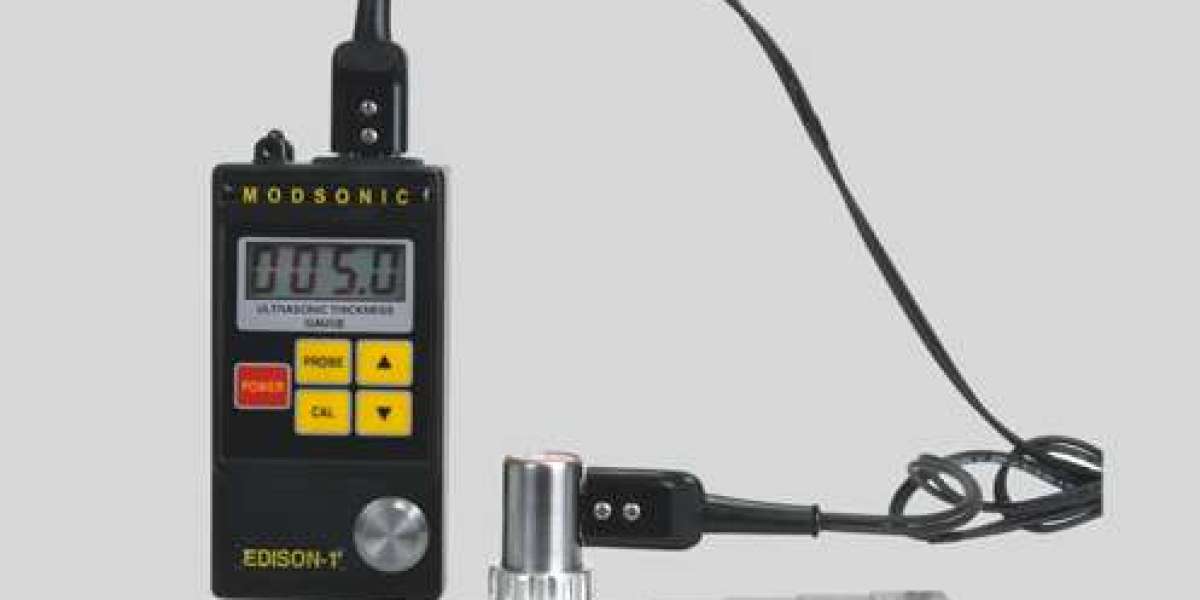Preventive maintenance is a proactive approach to maintaining equipment and infrastructure, aiming to prevent failures before they occur. One crucial tool in this strategy is the ultrasonic thickness tester. This device plays a vital role in detecting material degradation and ensuring the longevity of assets. In this blog, we'll explore the role of ultrasonic thickness testers in preventive maintenance, highlighting their benefits and providing insights on how to effectively utilize them.
Understanding Ultrasonic Thickness testers
An ultrasonic thickness tester is a non-destructive testing device used to measure the thickness of materials. It operates by emitting high-frequency sound waves through a material and measuring the time it takes for the echo to return. The thickness is calculated based on the time interval and the known speed of sound in the material.
This technology allows for precise measurements without damaging the material, making it ideal for preventive maintenance. By regularly assessing the thickness of components, you can detect wear and tear, corrosion, and other issues before they lead to significant problems.
Benefits of Ultrasonic Thickness testers in Preventive Maintenance
1. Early Detection of Wear and Corrosion
One of the primary benefits of ultrasonic thickness testers is their ability to detect wear and corrosion early. Regular measurements of material thickness help identify thinning or degradation before it leads to equipment failure or structural damage.
- Corrosion Monitoring: Corrosion can cause gradual thinning of metal components, leading to potential failures. Ultrasonic thickness testers provide accurate readings, allowing for early detection and intervention.
- Wear Analysis: In machinery and equipment, regular thickness measurements help monitor wear patterns. Early detection of abnormal wear can prompt timely maintenance or replacement, preventing unexpected breakdowns.
2. Non-Destructive Testing
Ultrasonic thickness testers offer a non-destructive method for assessing material thickness. This is particularly important for components that cannot be easily repaired or replaced, such as pressure vessels, pipelines, and structural supports.
- Preserving Integrity: Since ultrasonic thickness testers do not damage the material, they allow for continuous monitoring without compromising the integrity of the component.
- Safe Testing: The non-destructive nature of the tester makes it suitable for testing in hazardous or sensitive environments where traditional methods might be impractical.
3. Accurate and Reliable Measurements
Accuracy is crucial in preventive maintenance, and ultrasonic thickness testers deliver precise measurements. This reliability ensures that maintenance decisions are based on accurate data, reducing the risk of errors and improving overall effectiveness.
- High Precision: Ultrasonic thickness testers provide detailed measurements with high precision, making them effective for identifying even minor changes in material thickness.
- Consistency: Regular use of ultrasonic thickness testers ensures consistent data collection, which is essential for monitoring trends and making informed maintenance decisions.
4. Cost-Effective Maintenance
Implementing a preventive maintenance strategy with ultrasonic thickness testers can be cost-effective in the long run. By identifying issues early and addressing them before they escalate, you can reduce repair costs and minimize downtime.
- Reduced Repair Costs: Early detection of issues allows for timely repairs or replacements, preventing more extensive damage and costly repairs.
- Minimized Downtime: Preventive maintenance helps avoid unexpected equipment failures, reducing downtime and keeping operations running smoothly.
5. Comprehensive Data Collection
Ultrasonic thickness testers often come with data logging and analysis features, allowing for comprehensive data collection and trend analysis. This capability supports more informed decision-making and helps track the effectiveness of maintenance activities.
- Data Logging: Many ultrasonic thickness testers can record and store measurements over time. This data is valuable for tracking the progression of material degradation and evaluating maintenance strategies.
- Trend Analysis: Analyzing historical data helps identify patterns and trends, providing insights into the rate of wear or corrosion and informing future maintenance plans.
Implementing Ultrasonic Thickness testers in Preventive Maintenance
1. Select the Right Ultrasonic Thickness tester
Choosing the right ultrasonic thickness tester is essential for effective preventive maintenance. Consider factors such as the material being measured, the thickness range, and the operating environment.
- Material Compatibility: Ensure that the tester is suitable for the materials you are working with, whether they are metals, plastics, or composites.
- Range and Resolution: Select a tester with the appropriate thickness range and resolution for your needs. Some testers are designed for specific applications or material types.
2. Establish a Regular Inspection Schedule
Integrate ultrasonic thickness measurements into your preventive maintenance schedule. Regular inspections help monitor the condition of components and identify any changes in thickness.
- Inspection Frequency: Determine the frequency of inspections based on the criticality of the components and their exposure to wear or corrosion.
- Documentation: Keep detailed records of each inspection, including measurements, locations, and any observations. This documentation is valuable for tracking changes over time and planning maintenance.
3. Prepare and Calibrate the tester
Proper preparation and calibration of the ultrasonic thickness tester are crucial for accurate measurements. Follow the manufacturer's instructions for calibration and ensure that the tester is in good working condition.
- Surface Preparation: Clean the surface of the material before taking measurements to ensure accurate results. Apply a couplant if necessary to improve the transmission of ultrasonic waves.
- Calibration: Regularly calibrate the tester using reference blocks with known thicknesses. Proper calibration ensures the accuracy of your measurements and helps maintain consistency.
4. Analyze and Interpret Data
Once you have collected measurements, analyze and interpret the data to assess the condition of the components. Look for signs of wear, corrosion, or other issues that may require attention.
- Compare Measurements: Compare current measurements to historical data and baseline readings to identify any significant changes in thickness.
- Evaluate Trends: Analyze trends in the data to determine the rate of degradation and plan appropriate maintenance activities.
5. Plan and Execute Maintenance
Based on your data analysis, plan and execute maintenance activities as needed. Address any issues identified during inspections to prevent further damage and ensure the continued reliability of your equipment.
- Prioritize Repairs: Prioritize repairs or replacements based on the severity of the issues and the potential impact on operations.
- Follow-Up Inspections: Schedule follow-up inspections to verify the effectiveness of maintenance activities and ensure that components remain in good condition.
Conclusion
Ultrasonic thickness testers play a vital role in preventive maintenance by providing accurate and reliable measurements of material thickness. Their non-destructive nature, early detection capabilities, and cost-effectiveness make them an essential tool for maintaining equipment and infrastructure. By selecting the right tester, establishing a regular inspection schedule, and effectively analyzing and interpreting data, you can enhance your preventive maintenance strategy and ensure the longevity and reliability of your assets.
Investing in ultrasonic thickness testers and integrating them into your maintenance practices will help you proactively manage wear and corrosion, reduce repair costs, and minimize downtime. With their ability to deliver precise measurements and comprehensive data, ultrasonic thickness testers are a valuable asset in any preventive maintenance program, supporting the success and efficiency of your operations.



